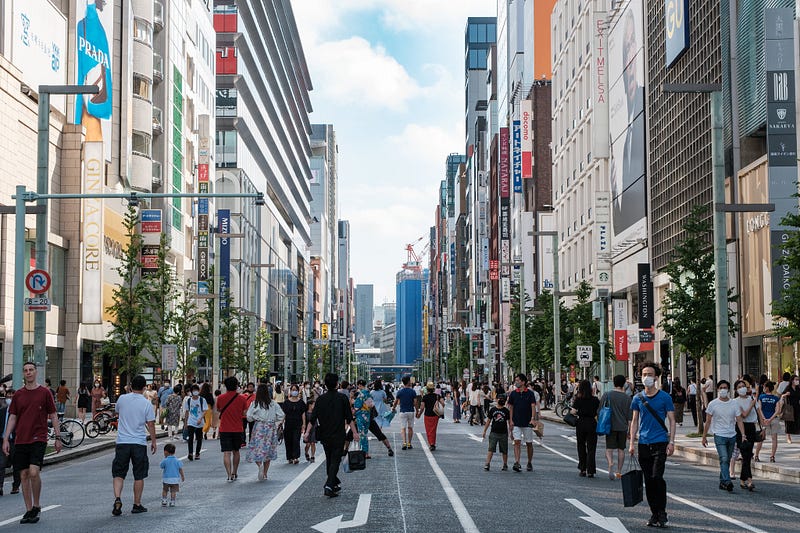Simulated Urbanism: the Sincerest Form of Flattery
We pay entrance fees to set foot in theme parks like Disneyland to experience simulated urbanism. Lifestyle centers are another example—shopping centers that are mixed-used and combine retail, restaurants, theaters, and more. These are car-free utopias where you can experience walkable urban environments (unlike where you actually live). This sounds great except for the fact that they’re pretend; they’re just imitating the real thing.
We drive our cars to these places to experience interesting, pleasant, and walkable mixed-use areas. In actuality, these are faux public spaces that are not actually public and are tightly regulated just to facilitate retail sales for those that can afford to visit or shop in them. In addition, these are often isolated areas sealed in by acres of parking lots with no real connection with the surrounding area or neighborhood.
Disneyland proves there’s just about an endless demand for clean, car-free areas.

Main Street USA in Disneyland, CA
Disneyland proves there’s just about an endless demand for clean, car-free areas. What’s not to like? It’s a place that’s enjoyable to walk around, from one attraction to another, with all the convenience of your typical amenities within reach.
Isn’t it ironic that we drive and pay fees to visit a place that simulates what our cities should be like in the first place?
Walkable Cities are Disneyland IRL
In walkable cities like Tokyo, your quality of life just feels upgraded. I liken it to if Disneyland was a giant city that people actually lived in. It’s clean, safe, organized, and orderly. The city is vibrant with life, and there is food, shopping, and attractions everywhere. Maps and directories are accessible to find your destinations, there’s convenience stores at every corner. You can walk, take the train, or ride a bike to actual destinations and not just for exercise. Good quality food is affordable, living spaces are affordable—albeit small but functional, public transportation is robust and reliable.

Miyashita Park displays a mix of various modes of transport and public space in Shibuya, Tokyo
It’s the feeling of true freedom. You feel like anywhere is accessible on foot. There is amazing public art and architecture to see and experience without spending a dime.
In fact, many experiences are free of charge and change with each season:
- In Spring, there’s cherry blossom viewings across parks, rivers, and streets all across the country.
- In Summer, there‘s festivals and firework displays.
- In Autumn, there’s the fall color changes of the foliage.
- In Winter, there are illumination displays (Christmas lights) that light up every city.

Picnicking under the cherry blossoms is a seasonal tradition across Japan
The Tearing Fabric of Society
Cars are tearing apart our social fabric. They dehumanize and disconnect us. They foster an us vs. them mentality. We have welcomed these 2-ton elephants into our streets that are trampling our humanity.

The Unhappiest Place on Earth-a weekday afternoon stuck in rush hour traffic
Car-designed infrastructure has robbed millions of us of our safety and the opportunity to live a more efficient and practical life.
- It’s robbed tens of thousands of lives each year who were taken prematurely in car collisions.
- It’s robbed the earth of precious resources while polluting our air.
- It’s robbed thousands of dollars per year from each of us by adopting a more practical mode of transportation.
- It’s robbed our society of tremendous socioeconomic benefits that would increase the quality of life for millions of people.
Walking, biking, and public transit keep us more mentally engaged with our environment. The benefits are varied and endless, I’ve even yet to mention the increased health and life expectancy when more people are actively walking and biking everyday.

This street becomes a pedestrian zone on weekends in Ginza, Tokyo
How We Live: Public vs. Private Spaces
In Japan, there is a sense of harmony and respect with a person and their environment. While public spaces are for everyone to enjoy and thus it’s everyone’s responsibility to maintain and look after them. This collective mindset carries into public infrastructure investment which ensures benefits to all in society.
This is opposed to the US, where private property and ownership reigns supreme. As we proportionally invest more of our time in them, our cars and homes are growing larger. And due to our lack of social safety nets, much of our energy is spent concerned about financial security and material accumulation which provide us a sense of status and meaning. The trade off is that our public infrastructure has diminished into a state of disrepair and our sense of community along with it.
In a place like Japan, much more time is spent in communal spaces like parks, cafes, arcades, or even rooftop gardens. In return, an appreciation for the environment, one another, and sensory experiences are fostered.
It’s a stark difference in how people live between the two countries.
Instead of having to visit places like Disneyland, we can actually live in places like Disneyland.

Namba Parks is a mixed-use commercial development with a public rooftop garden in Namba, Osaka
Safe city infrastructure really comes down to respecting and celebrating how we live. The spectrum of daily life as measured by safety, access, and convenience, could all be vastly improved by reducing car dependency. If we shift our focus into car-free infrastructure investment, it would transform our cities to everyone’s benefit. As a result, instead of having to visit places like Disneyland, we can actually live in places like Disneyland.





